
The practice of bonsai itself is an art that catches the attention of anyone, but when that art is presented in a glass it elevates it and multiplies its charm. The Bonsai terrarium is a unique balance between indoor beauty and art and you can create the beauty with ease by following a few steps. This article will cover the following topics;
- What is bonsai terrarium
- Can bonsai be kept in a terrarium?
- Best bonsai trees for terrarium
- How to create a bonsai terrarium
- How to care for bonsai terrarium
What is a bonsai terrarium?
Bonsai Terrariums are glass jars in which you can grow your bonsai. Typically, a terrarium is a curved container with a lid. It’s filled with layers of pebble, charcoal, moss, and potting medium to create a tiny garden. They are ornamental and bring a little bit of outdoors indoors. These small gardens improve the look of any living area. Bonsai trees can be grown in different sizes. Because terrariums are generally small, small-sized bonsais are perfect. Small-sized bonsai trees that are tiny enough to fit in the palm of your hand and can comfortably survive inside the glass jars.
There are two types of terrariums: open terrariums and closed terrariums.
Open terrarium:
Some people may pick an open terrarium. These terrariums have a big space at the top to give an abundance of airflow. The boosted airflow tends to make this type of terrarium a lower moisture atmosphere than most.
If you prefer an open terrarium, make sure to pick a bonsai that will endure these lower humidity conditions. There are several attractive terrarium choices, like this one, that you can start with.
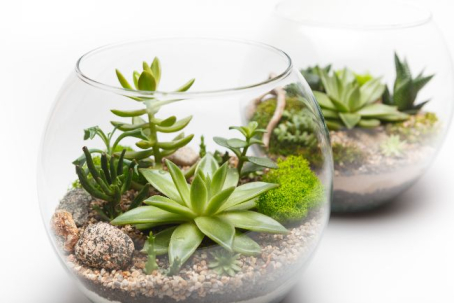
Close terrarium:
The opposite of an open terrarium is a closed terrarium, probably only has a little gap at the top, a gap in the side, or no gap at all. These terrariums are generally high in humidity and can survive in any light requirement.
They can be utilized for bonsai terrariums if the bonsai tree enjoys these circumstances. Look specifically for rainforest species for these terrariums.
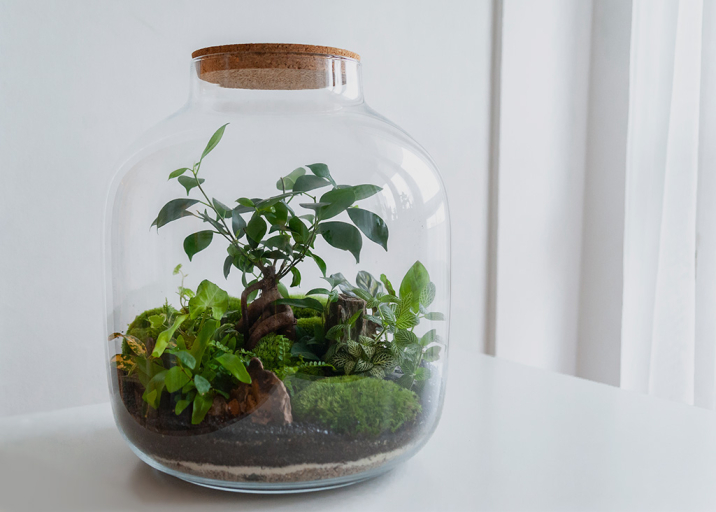
Can bonsai be kept in a terrarium?
Well, absolutely yes, but like any bonsai plant, there are going to be caveats,
Every bonsai species is special, so different bonsai species have distinct environmental urges and needs. However, not all tree types can resist the terrarium growing conditions. Only trees with specific capabilities can successfully endure in a terrarium. These capabilities include size, moisture level toleration, and humidity toleration. In the following, we will discuss which are the best tree species for terrariums;
Best bonsai trees for terrarium:
1) Bougainvillea:
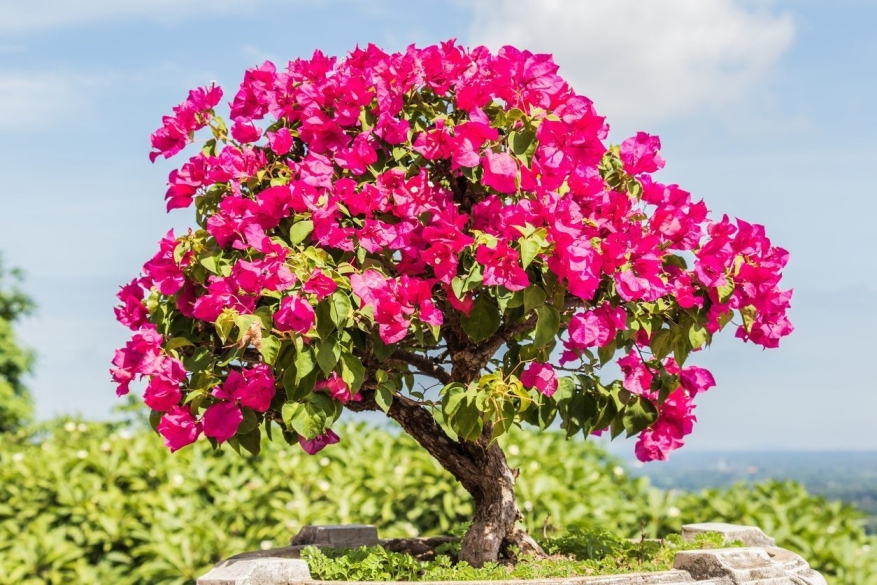
The bougainvillea can make a gorgeous, flowering bonsai tree in a terrarium. To get this bonsai to flower to its highest stretch, you must cycle it into warm, sunny conditions in summer and cool, dark conditions in winter. Because of this, the bougainvillea makes a proper bonsai terrarium choice.
[buy now]
2) Ficus
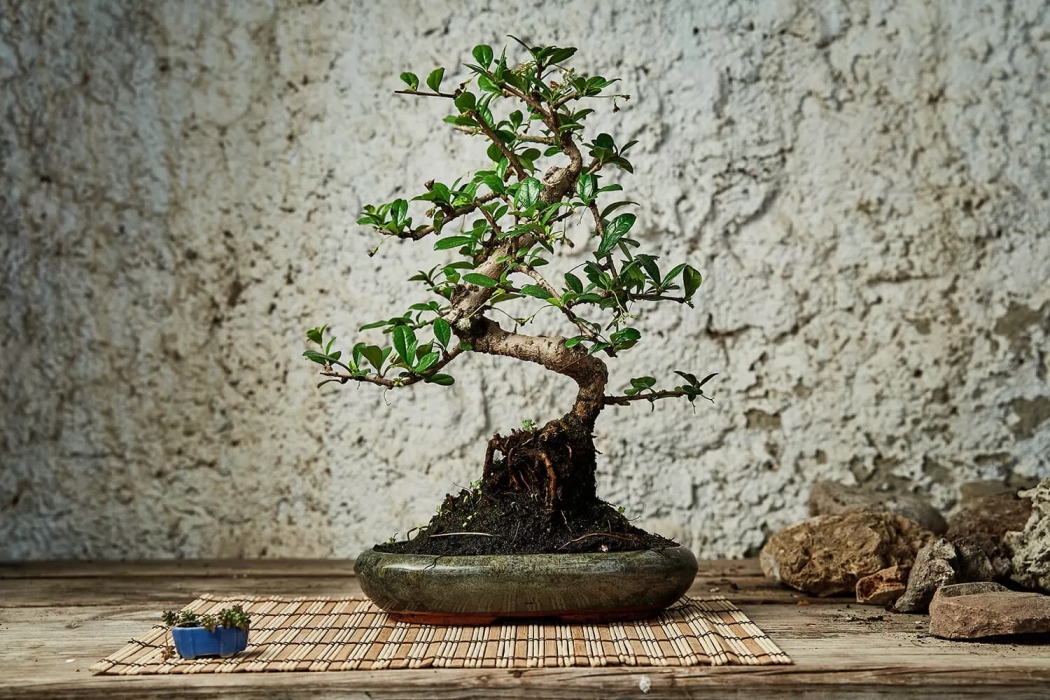
The Ficus is one of the most typical bonsai tree options because it is easier to manage than other bonsai species. The Ficus likes lots of light and stable temperatures that are properly beyond freezing. While it can handle drier water states, the Ficus will thrive in high-humidity conditions. Because of these factors, the ficus bonsai tree is a worthy candidate for either an open or closed terrarium. If you grow it in an open terrarium, you may have to moisten it more than other bonsai options. Of course, this is an ideal choice for a closed terrarium.
3) Fukien Tea
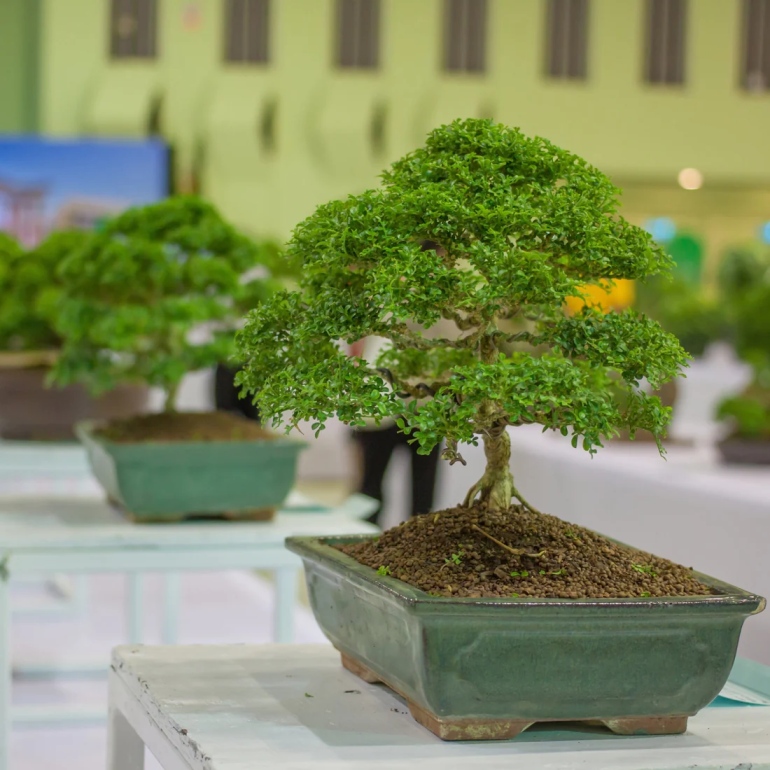
The Fukien Tea tree, or Carmona bonsai tree, is a moderately easy tree that can be utilized in a bonsai terrarium. The key to this lovely tree is to supply it with plenty of sunlight and make sure that it isn’t sitting in temperatures lower than room temperature. The soil of Carmona must be maintained moist but not soggy. This tree loves a highly humid, high-temperature condition. This makes the Fukien Tea tree a worthy species for a closed bonsai terrarium.
4) Jade plant
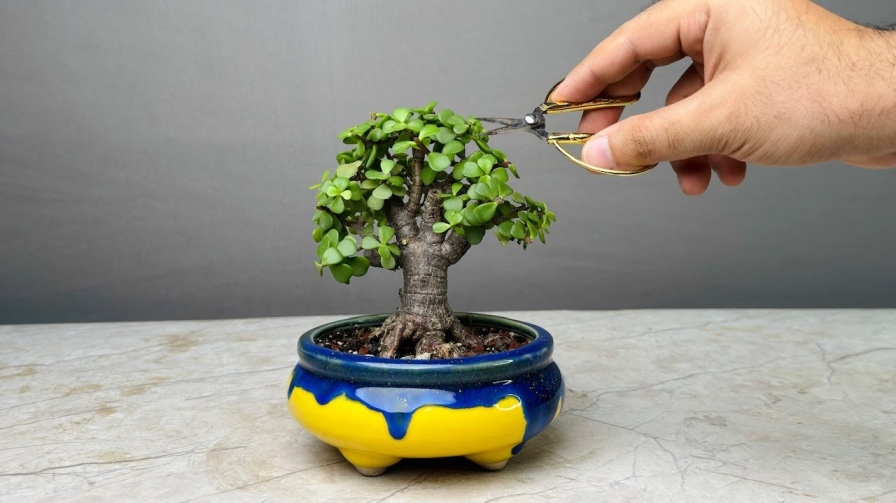
Jade bonsai is Compact in size, succulent nature, and tiniest maintenance needs. It’s ideal for a terrarium because it perfectly fits the little room of a terrarium, thriving in steady environments. Its succulent leaves hold water, making it enduring periodic negligence.
5) Chinese elm
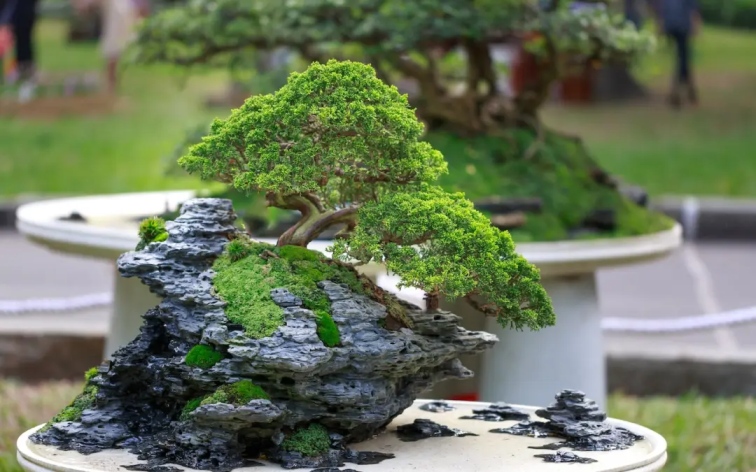
Chinese elm has fine branches, and small, vibrant leaves. It’s a worthy candidate for bonsai because it adds aesthetic charm to the miniature landscape with its delicate leaves. The Chinese Elm is adjustable and maintains a reasonable growth rate.
6) Juniper:
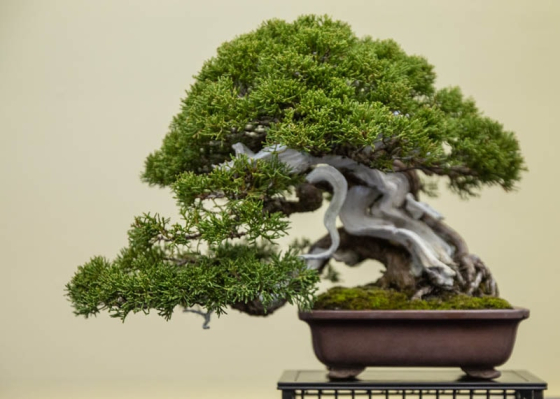
Juniper bonsai is compact in size, with needle-like leaves. It is well-adjusted to small rooms and holds a small format appropriate for terrariums. Its needle-like leaves donate to a classic bonsai formation which is why it can be a good terrarium plant.
How to create a bonsai terrarium:
Necessary Tools and Materials for Bonsai Terrarium
Making a successful bonsai terrarium ecosystem needs a thoughtful picking of tools and materials to guarantee a healthy and balanced setting.
Glass Container:
Opt for a transparent glass container, jar, or bowl to offer a fine view of your small landscape. Make sure the container’s size complements your bonsai’s development and equips comfortably within the terrarium area. If available, select a container with drainage holes to stop water from collecting at the base, lowering your bonsai’s chance of root rot.
Pruning Shears
Frequent pruning helps clear dead or overgrown stems, encouraging healthy growth and an aesthetically satisfying formation.
Watering Can or Spray Bottle:
A watering can with a long nozzle or spray bottle lets you deliver the right amount of moisture, controlling overwatering or shortage.
Chopsticks:
Bamboo chopsticks are convenient for testing the dampness in the soil. Insert them into it; if they come out a little damp, it signifies the right duration for watering.
Small Pebbles
Place a layer of small pebbles at the base of the jar to promote proper water movement.
Moss or Ornamental Components
Moss or other ornamental components or a ground cover can give an aesthetic charm to your terrarium. They also help maintain a humid climate, particularly in closed terrariums, contributing to a more steady humidity status.
Bonsai Soil Mix
An appropriate soil mixture is necessary for proper drainage and nutrient needs. A mixture of potting soil, perlite, and coarse sand makes an atmosphere that encourages root health and general plant terrarium vitality.
Miniature Rake
A small rake is convenient for teasing the soil surface, relaxing compacted soil, and making a neat impression in your bonsai terrarium. It’s a good tool for keeping the overall aesthetics.
Wire Cutters
The wire is mainly used in bonsai for shaping and training trunks and branches. Having wire cutters allows you to skillfully modify or remove wire without harming the delicate stems of your bonsai terrarium.
These are the steps for creating a bonsai terrarium.
- Clean and sanitize the terrarium.
- Add a light layer of the small pebbles to the base of the terrarium. The pebbles will function as drainage.
- Add a layer of soil or potting medium evenly over the pebbles. Be sure to use soil created especially for terrariums to avoid fungal growth.
- Add another layer of soil and make an incline on one side of the terrarium. The incline should take up most of the area in the terrarium. You will set the bonsai tree on the top of that incline.
- If preferred, add ornamental rocks over the soil. You can employ the rocks to make a fence between the sloped soil and the flat part.
- Set the bonsai tree on the slope. You may be required to adjust the slope by giving more soil around it.
- Add a layer of thin sand and ornamental objects until you achieve your preferred look.
- Add moss accordingly.
- Finally, use a spray bottle or a can to spray down the terrarium. Ensure not to overwater the jar.
- Put your bonsai terrarium near a window for indirect sunlight.
How to care for bonsai terrarium
You need to determine that a bonsai terrarium is going to do alright even if you don’t give it ideal circumstances. So many people think that everything has to be ideal for a bonsai to do okay and that just isn’t the issue. Just try to observe a few key guides in general.
Sunlight:
A bonsai terrarium will do nicely in a full to indirect sunny environment. That doesn’t imply that you should have it directly next to a very sunny window facing South. That just indicates that it requires about 6-8 hours of good filtered sun each day.
Soil:
For a bonsai terrarium, you’ll like to find soil with a couple of various components. There are soil mediums that are made especially for terrariums that can withstand decay, and fungus growth which will keep your terrarium healthy.
Water:
Bonsai trees like to be kept moist at all times but never saturated. Check your soil every day with a wooden chopstick and make sure that the top layer comes out damp. If it is dry, mist the topsoil so that it is moist again with a spray bottle or watering can.
Temperature:
Most bonsai species, even those in terrariums, prefer to be kept warm. Generally, if you maintain your bonsai terrarium at room temperature, your bonsai will thrive. Ensure if you have your bonsai outdoors, keep an eye on them for the temperature drop in the evening. Bring them inside if you can.
Fertilizer:
The most difficult part of maintaining a bonsai tree is fertilizing it adequately without over-fertilizing it. Symptoms of over-fertilizing include leaves turning yellow, or even dropping off. Most bonsai trees will do alright with fertilizer used once a month, at most, or even as little as twice a year.
Final words:
Terrariums offer a friendly, humid ecosystem in which some bonsai trees can survive without much complaint. Bonsais like ficus relish the high humidity and dampness in the soil. There are several notable challenges with maintaining a miniature bonsai tree in a terrarium. Your tree needs less watering and fertilizer, but mildew can be an issue. Luckily, there are easy remedies that can save your bonsai’s health.